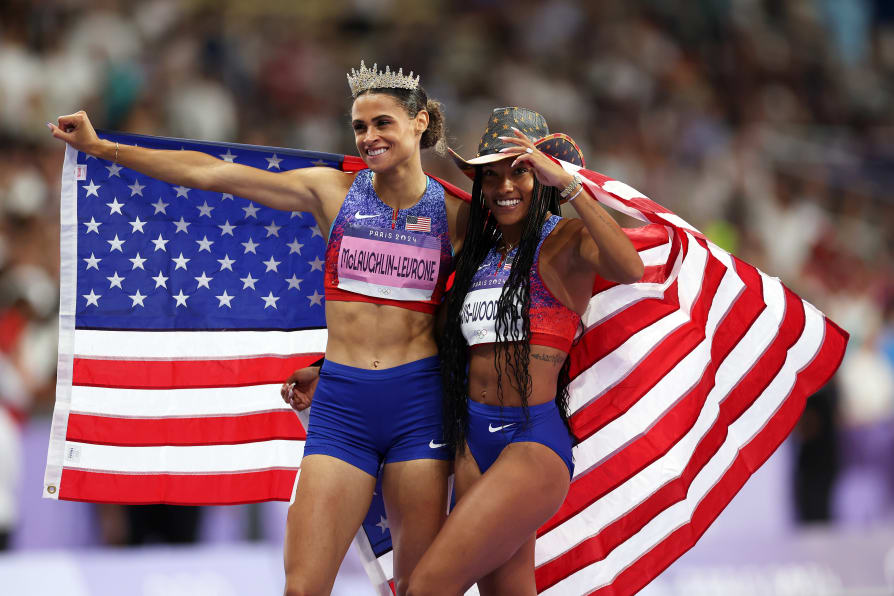It was a night to remember at the Paris 2024 Olympic Games, one that will surely be etched in the history books of U.S. track and field. Two electrifying performances from Sydney McLaughlin-Levrone and Tara Davis-Woodhall turned the Stade de France into a celebration ground as both athletes claimed gold medals and captured the world’s attention with dazzling displays of athletic brilliance.
The evening’s energy was unmatched as the two champions wrapped themselves in American flags, soaking in the atmosphere while donning symbolic crowns of victory. McLaughlin-Levrone wore a tiara, a playful gift from her sister-in-law that became an unexpected accessory to her world-beating performance, while Davis-Woodhall sported a red, white, and blue cowboy hat—a nod to her Texas Longhorn roots at the University of Texas. Together, they embodied the joy, flair, and dominance of American track and field on the global stage.
McLaughlin-Levrone: Shattering Records and Pushing Limits
For Sydney McLaughlin-Levrone, gold was hardly enough. The 25-year-old superstar once again broke her own world record in the women’s 400-meter hurdles, clocking in at an astonishing 50.36 seconds. With this run, she edged out Dutch rival Femke Bol and American teammate Anna Cockrell, who pushed her all the way to the finish. Cockrell herself had a personal best, running 51.87 seconds to secure a silver medal for Team USA.
What makes McLaughlin-Levrone’s achievement extraordinary isn’t just her ability to win—it’s her relentless pursuit of faster times and higher standards. Over the past three years, she has demolished the barriers in her event with a level of consistency rarely seen in athletics. Back in 2021, she became the first woman in history to run under 52 seconds, setting the standard at 51.90. Weeks later, under the spotlight of the Tokyo 2020 Games, she defeated reigning champion Delilah Muhammad with a jaw-dropping 51.46.
Since then, McLaughlin-Levrone has rewritten the record books time and again. At the 2024 U.S. Olympic Trials, she stopped the clock at 50.65 seconds—already a performance many thought couldn’t be topped. Yet in Paris, she found another gear, producing her sixth world record in just three years.
And the frightening reality for her competitors? She isn’t done yet. Speaking after her race, McLaughlin-Levrone humbly admitted there were sections of her run she felt she could improve. Her eyes are now fixed on something that once seemed impossible: breaking the 49-second barrier.
“I do think 49 is possible,” she said, acknowledging that her progression suggests the milestone is within reach. “I don’t know when it’s possible, but it’s out there for sure.”
Should she succeed, McLaughlin-Levrone would achieve what many track analysts consider one of the greatest feats in sprinting history. Her steady improvement—nearly 1.5 seconds in just over three years—underscores not only her immense physical gifts but also her unmatched mental focus, honed through years of competing on the biggest stages.
Davis-Woodhall: A Golden Leap into History
While McLaughlin-Levrone was soaring over hurdles, Tara Davis-Woodhall was soaring through the air. The long jump sensation claimed her first Olympic gold medal with a leap of 7.10 meters (23 feet, 3 inches), sealing her place among the greats. Her celebration, complete with the cowboy hat, wasn’t just a nod to her college days but also a personal expression of joy, individuality, and Texan pride.
For Davis-Woodhall, this victory represented more than just distance. It was the culmination of years of hard work, perseverance, and belief. The field was competitive, but her determination to rise above the rest carried her to the top of the podium. Adding to Team USA’s dominance in the event, Jasmine Moore secured the bronze medal, giving the Americans a gold-and-bronze double.
Davis-Woodhall’s success adds another layer to the story of this golden generation of U.S. track and field athletes. Her win, alongside McLaughlin-Levrone’s historic performance, reinforced America’s strength in both technical and speed-driven events.
A Banner Day for Team USA
The combination of medals told the story best: McLaughlin-Levrone’s gold and world record, Davis-Woodhall’s golden leap, Cockrell’s silver in the hurdles, and Moore’s bronze in the long jump. In one evening, the United States not only dominated events but also showcased the depth of its talent across disciplines.
For McLaughlin-Levrone, the night also held personal significance—it came just a day after her 25th birthday. For Davis-Woodhall, it marked the realization of a lifelong dream. Together, they epitomized the spirit of resilience, ambition, and excellence that has long defined Team USA at the Olympic Games.
The image of the two champions side by side—one with a tiara, the other with a cowboy hat—will surely become one of the most iconic visuals of Paris 2024. It symbolized more than victory; it was about personality, culture, and the joy of achieving greatness on the world’s biggest stage.
As McLaughlin-Levrone looks toward the future, chasing the once-unthinkable 49-second mark, and Davis-Woodhall continues her ascent in the world of jumps, the world of track and field can only watch in awe. For now, though, U.S. fans can revel in the glory of a golden night that reminded everyone why the Olympics remain the ultimate showcase of human potential.

